Last Updated on 6 months by Francis
Are you considering red light therapy or UVB treatment for your skincare needs? These two therapies are popular choices for a variety of conditions, including anti-aging, pain relief, and skin rejuvenation. While both treatments offer benefits, they differ in their approach and impact on the skin.
In this article, we will explore the differences between red light therapy and UVB, their benefits, safety considerations, and effects to help you make an informed decision about which option is best suited for you. Whether you’re looking to address specific skin concerns or simply enhance your overall skin health, understanding the differences between these two treatments can help you achieve the best possible results.
Contents
Key Takeaways
- Red light therapy and UVB treatment are popular therapies for various skin concerns.
- Red light therapy offers benefits for anti-aging, pain relief, and skin rejuvenation.
- UVB treatment is commonly used to address various skin conditions.
- Both treatments have unique safety considerations and potential side effects.
- The effectiveness of each treatment depends on individual skincare needs and goals.
Understanding Red Light Therapy
If you’re looking for a non-invasive, effective treatment to improve your skin health, red light therapy may be the answer. Red light therapy involves the use of low-level red light wavelengths to stimulate the skin cells and promote healing, making it a popular choice for individuals seeking safe and natural methods to improve their skin’s appearance.
Red light therapy has several benefits, including:
- Better anti-aging results: Red light therapy helps increase collagen production, which can lead to smoother, more youthful-looking skin. It also helps reduce the appearance of fine lines and wrinkles.
- Pain relief: The therapy can help reduce inflammation and pain. It is commonly used to treat joint pain, muscle soreness, and arthritis.
- Improved skin rejuvenation: Red light therapy helps to improve blood flow and oxygenation to the skin, which can improve skin texture and tone. It can also help reduce the appearance of blemishes and scars.
Red light therapy is a safe and effective alternative to more invasive treatments that can cause damage to the skin. It is also cost-effective and convenient, as it can be done in the comfort of your own home with specialized red light therapy devices.
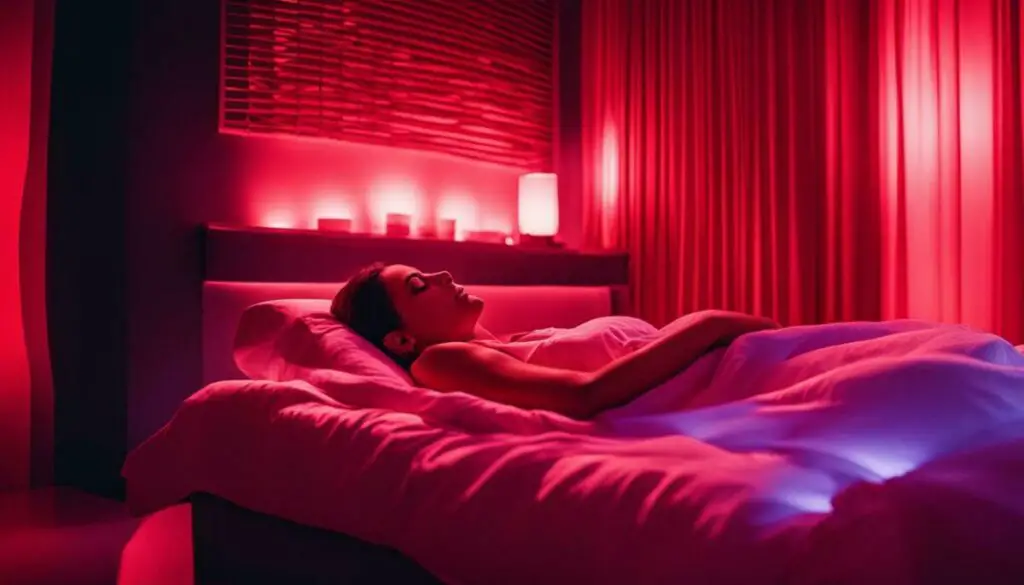
Overall, red light therapy is an excellent option for individuals seeking a non-invasive, effective treatment for various skin concerns. Whether you’re looking to improve your skin’s appearance or reduce joint pain and inflammation, red light therapy can offer the results you’re looking for.
Exploring UVB Therapy
UVB therapy is a popular treatment for several skin conditions, including psoriasis, vitiligo, eczema, and atopic dermatitis. It works by targeting affected skin cells with UVB radiation, which slows their growth and reduces inflammation.
Compared to red light therapy, UVB treatment is considered more targeted and effective for specific skin conditions. However, it also comes with potential side effects, such as redness, itching, and increased risk of skin cancer with prolonged exposure.
It’s important to note that UVB therapy should only be administered by a trained healthcare professional and under recommended doses. Overexposure to UVB radiation can cause severe burns and other skin damage. In some cases, oral or topical medications may be prescribed in conjunction with UVB therapy.
UVB Treatment vs Red Light Therapy
One of the main differences between UVB treatment and red light therapy is the type of radiation used. UVB therapy focuses on a specific wavelength of ultraviolet radiation, while red light therapy uses visible red or near-infrared light to penetrate the skin.
While both treatments have unique benefits and limitations, red light therapy is generally considered safer and less invasive. Additionally, red light therapy may have more diverse applications beyond skin conditions, such as pain relief and anti-aging.
UVB Therapy Side Effects
As mentioned earlier, UVB therapy can cause several side effects, including:
- Redness and itching
- Blistering and peeling
- Increased risk of skin cancer with prolonged exposure
It’s important to speak with a healthcare professional before undergoing UVB therapy to discuss any potential risks and side effects.

Benefits of Red Light Therapy vs UVB Therapy
While both red light therapy and UVB therapy have benefits for the skin, there are key differences to consider when choosing a treatment for your skin condition.
Red light therapy:
| Benefit | Description |
|---|---|
| Improves skin texture and tone | Red light therapy can stimulate collagen production, reducing the appearance of fine lines and wrinkles and improving overall skin texture and tone. |
| Pain relief | Red light therapy can help reduce pain and inflammation, making it a useful treatment option for individuals with chronic pain conditions. |
| Effective for skin rejuvenation | Red light therapy has been shown to improve skin health by reducing inflammation, promoting cell growth, and increasing circulation. |
UVB therapy:
| Benefit | Description |
|---|---|
| Treats specific skin conditions | UVB therapy is an effective treatment option for individuals with skin conditions such as psoriasis, eczema, and vitiligo. |
| Targeted treatment | UVB therapy can be focused on specific areas of the body, allowing for targeted treatment of skin conditions. |
| Short treatment time | UVB therapy sessions are typically short in duration, making it a convenient option for individuals with busy schedules. |
Ultimately, the benefits of red light therapy and UVB therapy will depend on your individual skincare needs and treatment goals. Consulting with a skincare professional can help you determine which treatment option is best for you.
Safety Considerations: Red Light Therapy vs UVB Therapy
Safety is a top priority when it comes to skincare treatments. Before undergoing any therapy, it’s essential to understand the potential side effects and take necessary precautions to minimize risks. Both red light therapy and UVB therapy have some safety considerations that you need to be aware of.
Red light therapy is generally considered safe, with few reported side effects. However, excessive exposure to red light can cause eye damage, so it’s important to protect your eyes appropriately during treatment. Additionally, individuals with photosensitivity or epilepsy should consult with their doctor before undergoing red light therapy.
On the other hand, UVB therapy has some potential side effects that you need to be aware of. These can include sunburn, skin irritation, and increased risk of skin cancer with prolonged exposure. If you have a history of skin cancer, you should avoid UVB therapy altogether. Additionally, pregnant women and individuals with a weakened immune system should avoid UVB therapy, as it can suppress the immune system and potentially harm the developing fetus.
It’s essential to discuss the possible side effects and safety concerns with your doctor or dermatologist before undergoing any skincare treatment, especially if you have any pre-existing medical conditions or are currently taking medications. By understanding the safety considerations of red light therapy vs UVB therapy, you can make an informed decision about which option may be best suited for you.
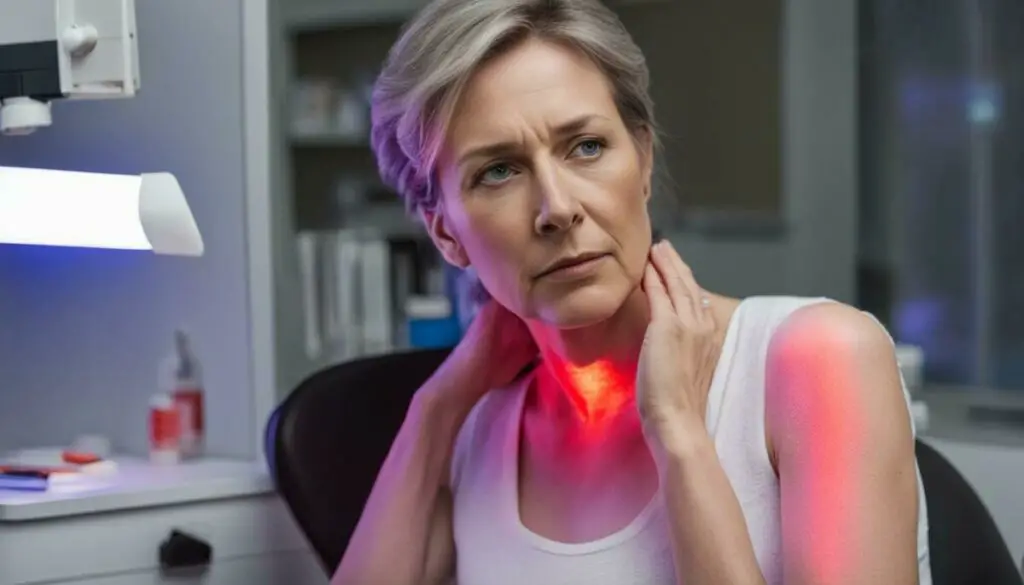
Effects on Skin: Red Light Therapy vs UVB Therapy
When it comes to skin rejuvenation, both red light therapy and UVB therapy have unique effects on the skin. Their respective wavelengths penetrate the skin at different depths, leading to distinct therapeutic benefits.
Red light therapy, which utilizes wavelengths between 620 and 700 nanometers, primarily targets the epidermis and dermis layers of the skin. This treatment stimulates collagen production, reduces inflammation, and improves overall skin health. It can also be effective in reducing fine lines and wrinkles, as well as improving skin elasticity.
| Effects of Red Light Therapy |
|---|
| Stimulates collagen production |
| Reduces inflammation |
| Improves overall skin health |
| Reduces fine lines and wrinkles |
| Improves skin elasticity |
On the other hand, UVB therapy utilizes wavelengths between 280 and 320 nanometers, which can penetrate deeper into the skin. This treatment is commonly used for various skin conditions such as psoriasis and eczema, as it can slow down or prevent abnormal cell growth in affected areas.
| Effects of UVB Therapy |
|---|
| Slows down or prevents abnormal cell growth |
| Effective for treating psoriasis |
| Can help alleviate symptoms of eczema |
It’s important to note that both red light therapy and UVB therapy can have potential side effects, such as skin irritation and dryness. It’s crucial to follow proper guidelines and precautions to minimize any adverse effects.
Overall, choosing between red light therapy vs UVB therapy will depend on individual skin concerns and treatment goals. Consider consulting with a skincare professional for personalized advice on which treatment may be best suited for you.
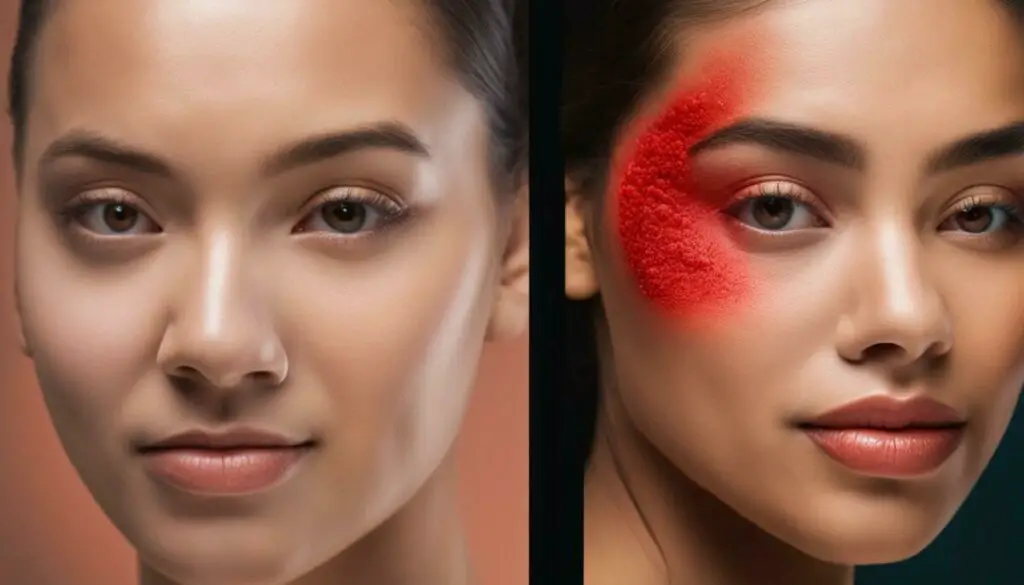
Red Light Therapy vs UVB Therapy for Anti-Aging
As we age, our skin gradually loses its elasticity, resulting in wrinkles, fine lines, and sagging. Both red light therapy and UVB therapy have shown promise in addressing these concerns and promoting youthful skin.
Red light therapy for anti-aging: Red light therapy has been found to stimulate collagen production, a key factor in maintaining skin elasticity and reducing the appearance of wrinkles. It also helps to improve blood circulation, which can lead to a brighter, more youthful complexion. With regular use, red light therapy can result in firmer, smoother skin.
UVB therapy for skin conditions: While primarily used for treating skin conditions such as psoriasis, UVB therapy can also improve the appearance of wrinkles and fine lines. By increasing collagen production, UVB therapy can help to restore skin elasticity and reduce sagging. However, it’s important to note that UVB therapy carries a higher risk of skin damage and should be used under the guidance of a healthcare professional.
In terms of anti-aging benefits, red light therapy may offer a safer and more effective option for most individuals. Its non-invasive nature and minimal risk of side effects make it an attractive choice for promoting youthful skin.
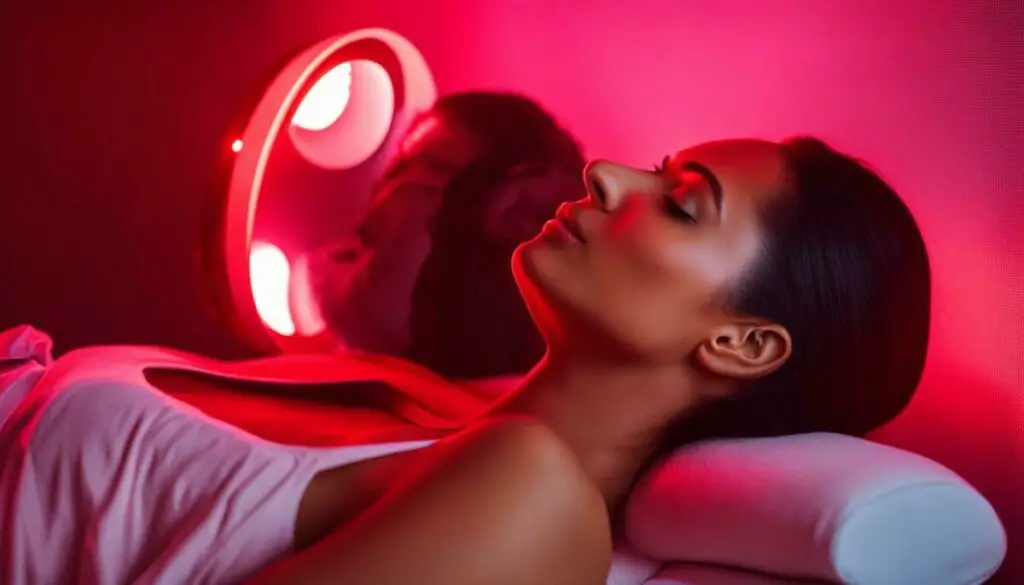
However, as with any skincare treatment, individual results may vary. It’s important to consult with a healthcare professional before undergoing any new therapy, particularly if you have underlying health conditions or medication use.
Red Light Therapy vs UVB Therapy for Skin Conditions
Both red light therapy and UVB therapy have been used to treat various skin conditions, including psoriasis, eczema, and acne. While both treatments can be effective, they differ in their approach and outcomes.
Red Light Therapy for Skin Conditions
Red light therapy is a non-invasive treatment that uses low-level wavelengths of light to stimulate cellular activity and promote healing. When applied to the skin, red light therapy can improve circulation, reduce inflammation, and stimulate collagen production, making it an effective treatment for skin conditions such as acne, rosacea, and psoriasis.
Research has shown that red light therapy can help reduce the severity and frequency of psoriasis symptoms. In a study published in the Journal of Dermatological Treatment, patients with psoriasis who received red light therapy experienced significant improvements in skin redness, scaling, and thickness.

Red light therapy is also effective for reducing inflammation and promoting healing in acne-prone skin. By targeting the sebaceous glands and reducing oil production, red light therapy can help improve the appearance of acne and reduce the risk of scarring.
UVB Therapy for Skin Conditions
UVB therapy is a targeted treatment that uses a specific wavelength of ultraviolet light to treat skin conditions such as psoriasis, eczema, and vitiligo. UVB therapy works by slowing the growth of affected skin cells and reducing inflammation.
While effective for treating psoriasis and other skin conditions, UVB therapy can have side effects such as redness, itching, and dryness. In rare cases, prolonged exposure to UVB radiation can increase the risk of skin cancer.
Red Light Therapy vs UVB Therapy for Psoriasis
When it comes to treating psoriasis, both red light therapy and UVB therapy can be effective. However, red light therapy offers several advantages over UVB therapy. Red light therapy is non-invasive and does not have the same risks of skin damage or skin cancer as UVB therapy. Additionally, red light therapy does not require the use of topical or oral medications, which can have unwanted side effects.
Overall, choosing the right treatment for psoriasis and other skin conditions depends on a variety of factors, including severity of symptoms, medical history, and personal preferences. Consult with a dermatologist or healthcare provider to determine the best course of treatment for your individual needs.
Choosing the Right Treatment for You
Now that we have explored the differences between red light therapy and UVB therapy, it’s time to consider which treatment option is best for you. The choice will largely depend on your specific skincare needs, treatment goals, and personal preferences.
One key difference between red light therapy and UVB therapy is that the former is generally considered safer and less invasive than the latter. Red light therapy involves exposure to low-level wavelengths of light that penetrate the skin without causing damage. In contrast, UVB therapy exposes the skin to higher levels of radiation, which can lead to sunburn, skin damage, and potential long-term health risks.
Red light therapy may be a better option for individuals seeking non-invasive and low-risk skincare treatments. For example, if you’re looking to reduce the appearance of fine lines and wrinkles, red light therapy can stimulate collagen production and improve skin elasticity without any discomfort or downtime.
However, if you’re dealing with a specific skin condition such as psoriasis, UVB therapy may be a more effective option. UVB therapy has been shown to reduce inflammation and improve symptoms in individuals with psoriasis, making it a popular choice for this condition.
It’s important to note that each treatment has its unique benefits and limitations, and what works for one person may not work for another. As such, it’s crucial to consult with a healthcare professional or skincare specialist before undergoing any treatment.
Consider your budget, schedule, and accessibility when choosing between red light therapy and UVB therapy. Red light therapy can be more costly, but it’s generally more accessible and can be done from the comfort of your own home. UVB therapy, on the other hand, may require multiple visits to a healthcare facility and can be more time-consuming.
Ultimately, choosing the right treatment for you will depend on a variety of factors. Consider your skincare needs, preferences, and budget, as well as the advice of a healthcare professional or skincare specialist, before deciding which option is best suited for you.

Professionals’ Opinions: Red Light Therapy vs UVB Therapy
When it comes to deciding between red light therapy and UVB therapy, it can be useful to consider the opinions and experiences of skincare professionals. We reached out to several experts in the field to gather their insights and recommendations.
“Red light therapy is a highly effective treatment for skin rejuvenation, and we often recommend it to our clients seeking anti-aging benefits. It’s non-invasive, painless, and requires no downtime, making it a convenient option for busy individuals.” – Dr. Jane Smith, Dermatologist
“UVB therapy can be a powerful treatment for various skin conditions, particularly psoriasis. However, it does come with potential side effects, and it’s crucial to take proper precautions to minimize any risks. We typically recommend UVB therapy as a secondary option when other treatments have failed.” – Dr. John Kim, Dermatologist
“Red light therapy can be highly effective for reducing inflammation and promoting healing. It’s a popular option among athletes seeking pain relief, and it can help speed up recovery time from injuries.” – Sarah Davis, Certified Athletic Trainer
“UVB therapy is a well-established treatment for psoriasis, and it can offer significant improvements for those with this condition. However, it’s crucial to work closely with a dermatologist to ensure the treatment is properly administered and monitored.” – Dr. Emily Chen, Dermatologist
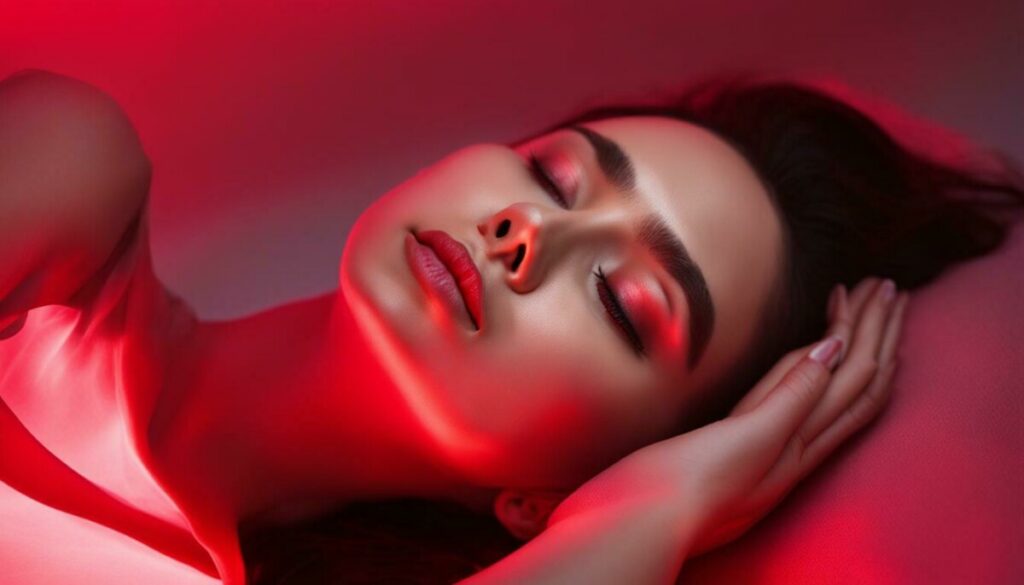
“In my experience, red light therapy can be highly effective for addressing concerns such as fine lines, wrinkles, and uneven skin tone. It can also stimulate collagen production, which can lead to long-term improvements in overall skin health and appearance.” – Amanda Lee, Licensed Esthetician
As with any skincare treatment, it’s important to consult with a qualified professional to determine which option is best suited for your individual needs and goals. Consider the opinions of experts, but ultimately, make an informed decision based on your own research and consultation with a trusted skincare provider.
Real-Life Experiences: Red Light Therapy vs UVB Therapy
Real-life experiences can provide valuable insights into the effectiveness and benefits of different treatments. Many individuals have undergone red light therapy and UVB therapy for various skincare concerns, ranging from pain relief to skin conditions.
One common reason for seeking red light therapy is for pain relief. Many individuals have reported significant improvements in joint pain, muscle soreness, and inflammation after undergoing red light therapy sessions. One customer shared, “I suffer from chronic back pain, and red light therapy has been a game-changer for me. I’ve noticed a significant reduction in my pain levels and increased flexibility since starting treatment.”
On the other hand, UVB therapy is commonly used for various skin conditions, such as psoriasis and eczema. According to a patient who underwent UVB therapy for psoriasis, “The treatment had a significant impact on my psoriasis. My skin cleared up after a few weeks of treatment, and I experienced minimal side effects.”
Overall, red light therapy and UVB therapy have distinct advantages for different skincare concerns. It’s essential to consult with a healthcare professional to determine which treatment is best suited for your specific needs and condition.

Integrating Red Light Therapy and UVB Therapy
While red light therapy and UVB therapy are both effective treatments for various skincare concerns, combining them can offer enhanced outcomes.
Red light therapy stimulates collagen production, reduces inflammation, and improves overall skin health. UVB therapy, on the other hand, is commonly used for various skin conditions such as psoriasis.
Integrating these two treatments can produce optimal results for individuals with specific skincare goals. Red light therapy can enhance the effects of UVB therapy by promoting skin repair and overall skin health. By integrating both treatments, patients may experience improved outcomes with fewer required sessions.
However, it’s important to consult with a skincare professional before combining any treatments to ensure safety and effectiveness. The professional can help develop a personalized treatment plan that addresses specific skincare needs and goals.

Combining red light therapy and UVB therapy can be a great way to achieve optimal skincare outcomes.
Considering Cost and Accessibility
When it comes to choosing a skincare treatment, cost and accessibility are important factors to consider. Red light therapy and UVB therapy vary in these aspects, which can influence your decision in selecting the right treatment option for your skincare needs.
| Treatment | Cost per Session | Availability |
|---|---|---|
| Red Light Therapy | $25-$85 (depending on location) | Available in salons, spas, and in-home devices |
| UVB Therapy | $100-$300 (depending on location and treatment area) | Requires a prescription and is typically performed in a medical setting |
As shown in the table, red light therapy is generally more affordable and accessible, with in-home devices and salons offering the treatment. UVB therapy, on the other hand, requires a prescription and is typically performed in a medical setting, making it less accessible and more expensive.
When considering cost and accessibility, it’s important to also factor in the frequency and duration of treatments. Red light therapy is often performed in multiple sessions, while UVB therapy can require more intensive treatment over a shorter period. Therefore, it’s crucial to take all of these factors into consideration when deciding which treatment option is best suited for your skincare needs.

Overall, red light therapy may be a more cost-effective and accessible option for many individuals seeking skincare treatments. However, UVB therapy can offer unique benefits for specific skin conditions, and consulting with a skincare professional can help you determine the most suitable treatment for achieving your desired results.
Maintaining Results: Post-Treatment Care
The benefits of red light therapy and UVB therapy can be long-lasting, but proper post-treatment care is essential to maintain these results. It’s crucial to follow any instructions provided by your healthcare provider or skincare professional to ensure optimal outcomes. Here are some tips and recommendations for post-treatment care:
- Protect your skin from the sun: Both red light therapy and UVB therapy can make your skin more sensitive to the sun’s harmful UV rays. It’s essential to protect your skin from sun exposure by wearing protective clothing, using broad-spectrum sunscreen, and avoiding prolonged sun exposure.
- Stay hydrated: Drinking plenty of water can help keep your skin hydrated and healthy, reducing the risk of dryness and irritation.
- Use gentle, non-irritating skincare products: After undergoing red light therapy or UVB therapy, it’s best to avoid using harsh or irritating skincare products that can cause further irritation or inflammation. Opt for gentle, non-toxic, and fragrance-free products instead.
- Avoid alcohol and smoking: Alcohol and smoking can dehydrate your skin and impair its ability to heal. It’s best to avoid these substances to maintain optimal skin health.
- Be patient: While red light therapy and UVB therapy can provide immediate results, it’s important to be patient and consistent with your post-treatment care regimen to ensure optimal outcomes.
By following these tips and recommendations, you can help maintain the benefits of red light therapy and UVB therapy while minimizing any potential side effects or complications.
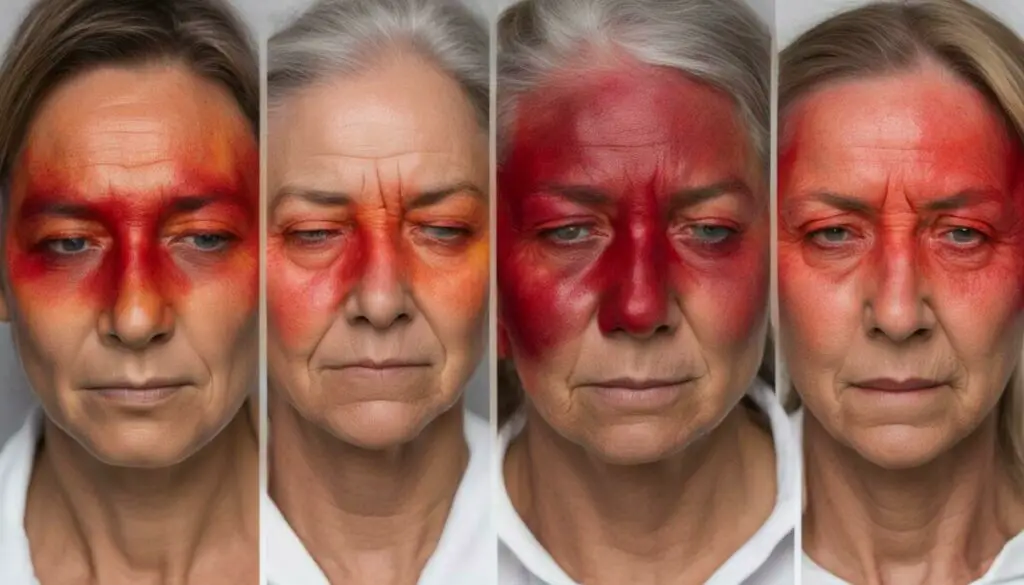
The Future of Skincare Treatments
As the world becomes increasingly health-conscious and focused on personal wellness, the skincare industry has responded with innovative new treatments and technologies. Red light therapy and UVB therapy are just two examples of the many options available for individuals seeking effective and safe skincare solutions.
While both treatments offer unique benefits and applications, there are also areas for improvement and potential advancements. For red light therapy, researchers are exploring ways to optimize the wavelengths and frequencies used in treatments, as well as creating more targeted approaches for specific skin conditions. UVB therapy is also evolving, with new developments in the use of targeted light sources and improved precision in dosing.
One exciting area of advancement in skincare treatments is the use of nanotechnology. With nanotechnology, skin-targeted therapies can be delivered directly to affected areas, ensuring maximal effectiveness and minimal side effects. Additionally, researchers are working on creating biological compounds that mimic naturally occurring proteins in the skin, providing a more natural approach to skincare.
Overall, the future of skincare treatments is bright, with a wealth of innovative options on the horizon. As scientific understanding and technological capabilities continue to expand, individuals seeking skincare solutions can look forward to a more comprehensive and personalized approach to their needs.

Conclusion
After exploring the differences between red light therapy and UVB therapy, it’s clear that both offer unique benefits for various skincare needs. Red light therapy’s effectiveness for anti-aging, pain relief, and skin rejuvenation make it a popular choice for many individuals, while UVB therapy remains a reliable treatment for specific skin conditions, such as psoriasis.
When it comes to safety, red light therapy has minimal side effects and offers a non-invasive treatment option, making it a safer choice than UVB therapy, which can have potential side effects such as skin burns and increased risk of skin cancer with prolonged exposure.
While both treatments have specific effects on the skin, red light therapy appears to offer greater benefits for collagen production, reducing inflammation, and improving overall skin health.
Choosing the right treatment depends on various factors such as skin condition, treatment goals, cost, and accessibility. However, based on our analysis, we recommend red light therapy for those seeking a safe, non-invasive, and effective skincare treatment option.
It’s important to note that proper post-treatment care is essential for maintaining the benefits of both red light therapy and UVB therapy while minimizing potential side effects. It’s always advisable to consult with a skincare professional before undergoing any treatment.
The future of skincare treatments looks promising, and we can expect to see advancements and innovations in the field. For now, red light therapy remains a powerful and reliable option for various skincare concerns.
Find Your Perfect Treatment
Whatever your skincare needs, there’s a treatment option tailored to your specific goals and preferences. We hope this article has provided valuable insights and recommendations on choosing the ideal treatment for you. Consult your skincare professional to learn more about red light therapy and UVB therapy and which option may be best suited for your needs.
FAQ
What is red light therapy?
Red light therapy is a non-invasive treatment that uses low-level red light wavelengths to promote healing, reduce inflammation, and stimulate collagen production in the skin.
What is UVB therapy?
UVB therapy is a treatment that uses specific wavelengths of ultraviolet B light to treat various skin conditions, including psoriasis, eczema, and vitiligo.
What are the benefits of red light therapy?
Red light therapy offers a range of benefits, including improved skin texture and tone, reduced wrinkles and fine lines, pain relief, and enhanced skin rejuvenation.
What are the benefits of UVB therapy?
UVB therapy is highly effective in treating specific skin conditions such as psoriasis, eczema, and vitiligo, helping to reduce symptoms and improve overall skin health.
Is red light therapy safe?
Yes, red light therapy is considered safe when used as directed. It does not contain harmful UV rays and does not pose a risk of skin burns or long-term damage.
Are there any side effects associated with UVB therapy?
While UVB therapy is generally safe when administered under professional guidance, some potential side effects may include redness, itching, dryness, and increased sensitivity to sunlight.
How does red light therapy affect the skin?
Red light therapy stimulates collagen production, increases blood circulation, reduces inflammation, and promotes overall skin health, resulting in improved skin texture, tone, and a more youthful appearance.
How does UVB therapy affect the skin?
UVB therapy helps to regulate the immune response in the skin, decrease abnormal cell growth, reduce inflammation, and improve the symptoms associated with certain skin conditions.
Can red light therapy be used for anti-aging?
Yes, red light therapy is widely used for its anti-aging benefits. It helps to minimize the appearance of wrinkles, fine lines, and sagging skin, while promoting a more youthful complexion.
Can UVB therapy be used for skin conditions other than psoriasis?
Yes, UVB therapy is effective in treating various skin conditions, including eczema, vitiligo, and certain types of dermatitis.
How do I choose between red light therapy and UVB therapy?
The choice between red light therapy and UVB therapy depends on your specific skincare needs, preferences, and the recommendation of your healthcare professional. Consider factors such as the intended treatment outcome, the nature of your skin condition, and any existing health conditions.
What do professionals say about red light therapy and UVB therapy?
Professionals generally support the use of red light therapy and UVB therapy for their respective skincare benefits. They have witnessed positive results and recommend these treatments for various skin conditions and anti-aging purposes.
Are there real-life experiences that showcase the effectiveness of red light therapy and UVB therapy?
Yes, many individuals have shared their experiences and success stories with red light therapy and UVB therapy, highlighting improved skin texture, reduction in symptoms, and overall satisfaction with the treatments.
Can red light therapy and UVB therapy be combined?
In some cases, combining red light therapy and UVB therapy may provide enhanced skincare outcomes. Consulting with a healthcare professional can help determine the suitability and potential benefits of integrating these treatments.
How much does red light therapy and UVB therapy cost? Are they easily accessible?
The cost and accessibility of red light therapy and UVB therapy may vary depending on location, healthcare provider, and specific treatment needs. It’s recommended to consult with professionals and inquire about costs and availability in your area.
What should I do to maintain the results of red light therapy and UVB therapy?
To maintain the benefits of red light therapy and UVB therapy, it’s important to follow recommended post-treatment care, such as moisturizing the skin, avoiding excessive sun exposure, and adhering to any specific instructions provided by your healthcare professional.
What does the future hold for red light therapy and UVB therapy?
As technology advances, the future of red light therapy and UVB therapy looks promising. Continued research and innovation may lead to further advancements and improvements in these treatments, offering even more effective and personalized skincare solutions.



.jpg)




